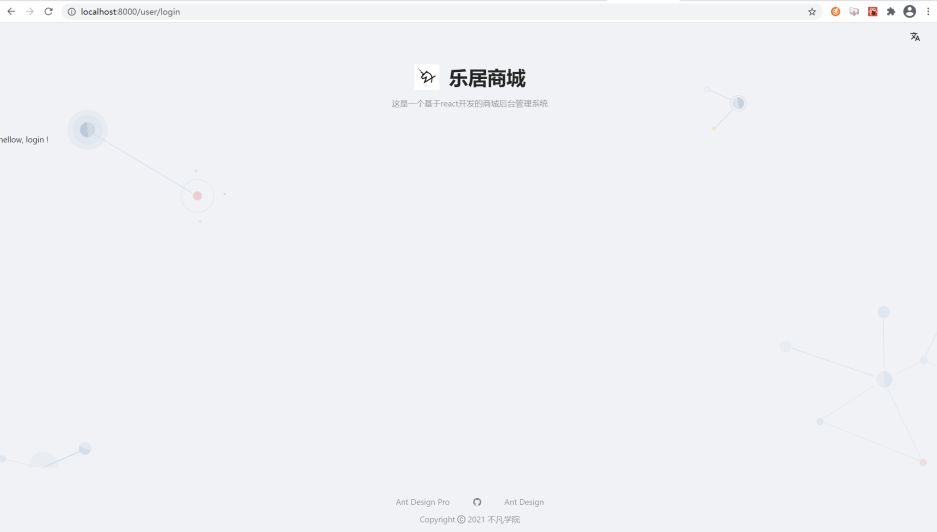Related code: react-demo-02
Create login page
The login template that comes with the framework template is relatively complex and does not meet our login needs, so we need to create a login page ourselves.
Createsrc/pages/Login/index.tsx
import React from 'react';
// 使用函数组件创建 虽然采用了typescript语法 ,但可以先像 js一样写代码.
const Login = ()=>{
return (
<div>
hellow, login !
</div>
)
}
export default Login;Modify routing file config/routes.ts
{
path: '/',
component: '../layouts/BlankLayout',
routes: [
{
path: '/user',
component: '../layouts/UserLayout',
routes: [
{
name: 'login',
path: '/user/login',
//===> 这里使用刚才创建的组件替换默认登录组件. /index.tsx 可以省略不写
component: './Login',
},
],
},Modify layouts/UserLayout.tsx component display information
import { GithubOutlined } from '@ant-design/icons';
...
<div className={styles.container}>
<div className={styles.lang}>
<SelectLang />
</div>
<div className={styles.content}>
<div className={styles.top}>
<div className={styles.header}>
<Link to="/">
<img alt="logo" className={styles.logo} src={logo} />
<span className={styles.title}>乐居商城</span>
</Link>
</div>
<div className={styles.desc}>
/* 国际化配置映射 */
<FormattedMessage id="pages.layouts.userLayout.title" defaultMessage="默认信息" />
</div>
</div>
{children}
</div>
/* 自定义底部
# https://procomponents.ant.design/components/layout/#footer
*/
<DefaultFooter
copyright={`${new Date().getFullYear()} 不凡学院`}
links={[
{
key: 'Ant Design Pro',
title: 'Ant Design Pro',
href: 'https://pro.ant.design',
blankTarget: true,
},
{
key: 'github',
title: <GithubOutlined />,
href: 'https://gitee.com/bufanxy/react-learn-demos',
blankTarget: true,
},
{
key: 'Ant Design',
title: 'Ant Design',
href: 'https://ant.design',
blankTarget: true,
},
]}
/>
</div>access http://localhost:8000/user/login

Create form
You can refer to the ant design document to create a form component. The src/pages/Login/index.tsx
style used here is less , which is a css precompiler like sass. Through modular introduction, it can be called directly in jsx. Note: Use camel case naming for attributes in jsx . Different from ordinary html specifications.
import React from 'react';
import { Form, Input, Button } from 'antd';
import styles from './index.less';
const Login = ()=>{
// 提交表单且数据验证成功后回调事件
const onFinish = v=>{
console.log('v',v);
}
// 提交表单且数据验证失败后回调事件
const onFinishFailed = v=>{
console.log('ev',v);
}
return (
<Form
className={styles.main}
labelCol = {
{span: 8}}
wrapperCol = {
{span: 16}}
onFinish= {onFinish}
onFinishFailed = {onFinishFailed}
>
<Form.Item
label="用户名"
name="username"
rules={[
{required: true ,message: '用户名不能为空!'}
]}
>
<Input/>
</Form.Item>
<Form.Item
label="密码"
name="password"
rules={[
{required: true, message: '密码不能为空!'}
]}
>
<Input.Password/>
</Form.Item>
<Form.Item
wrapperCol={
{
offset: 8,
span: 16
}
}
>
<Button type="primary" htmlType="submit">登录</Button>
</Form.Item>
</Form>
)
}
export default Login;
// ./index.less
.main{
width: 400px;
margin: 100px auto;
}
Using ant design, we can easily implement the layout of the login page. How to call the interface? Don't worry, there is a big difference here from the vue project. We need to first understand the logical layering of the project.